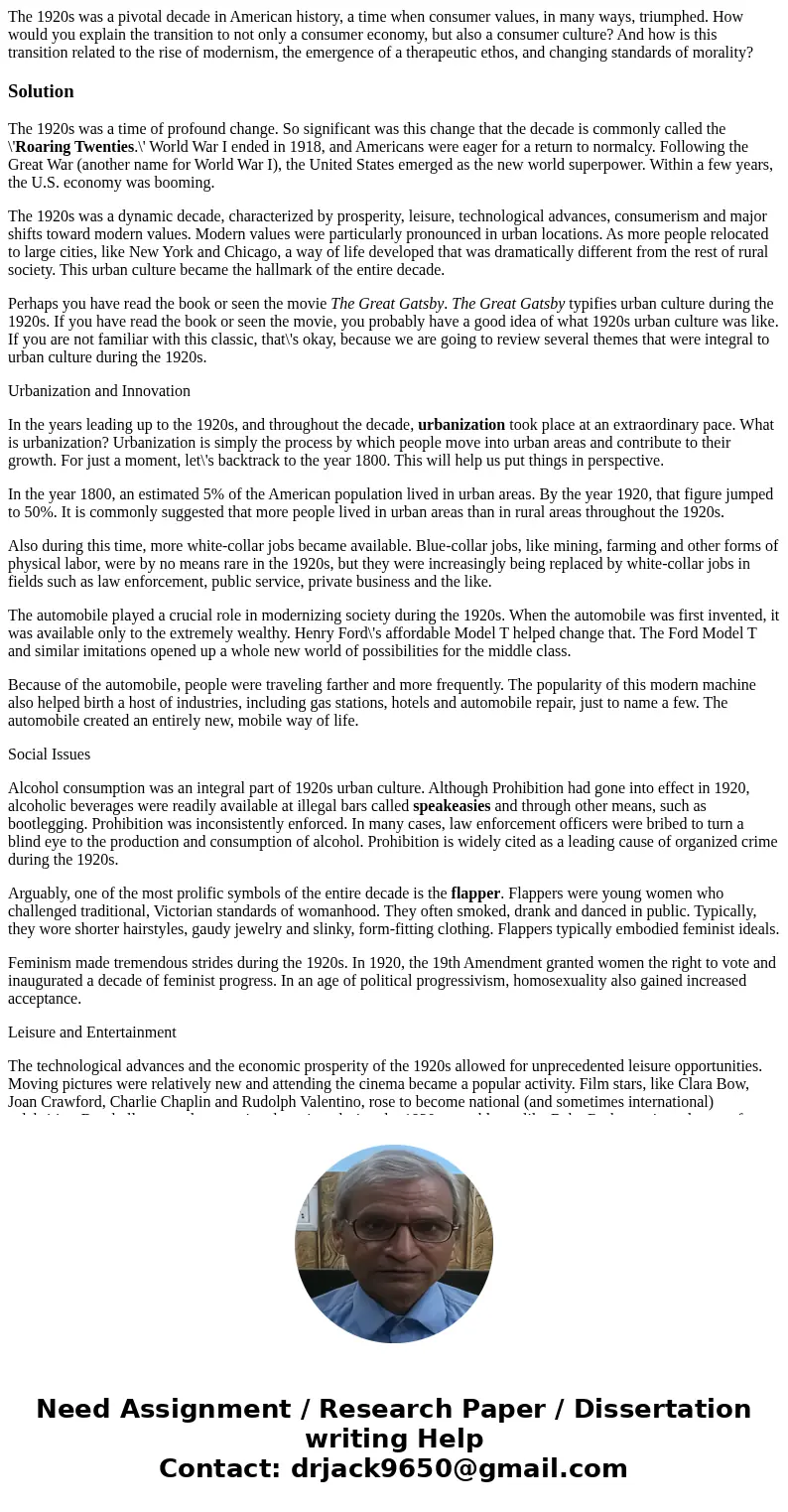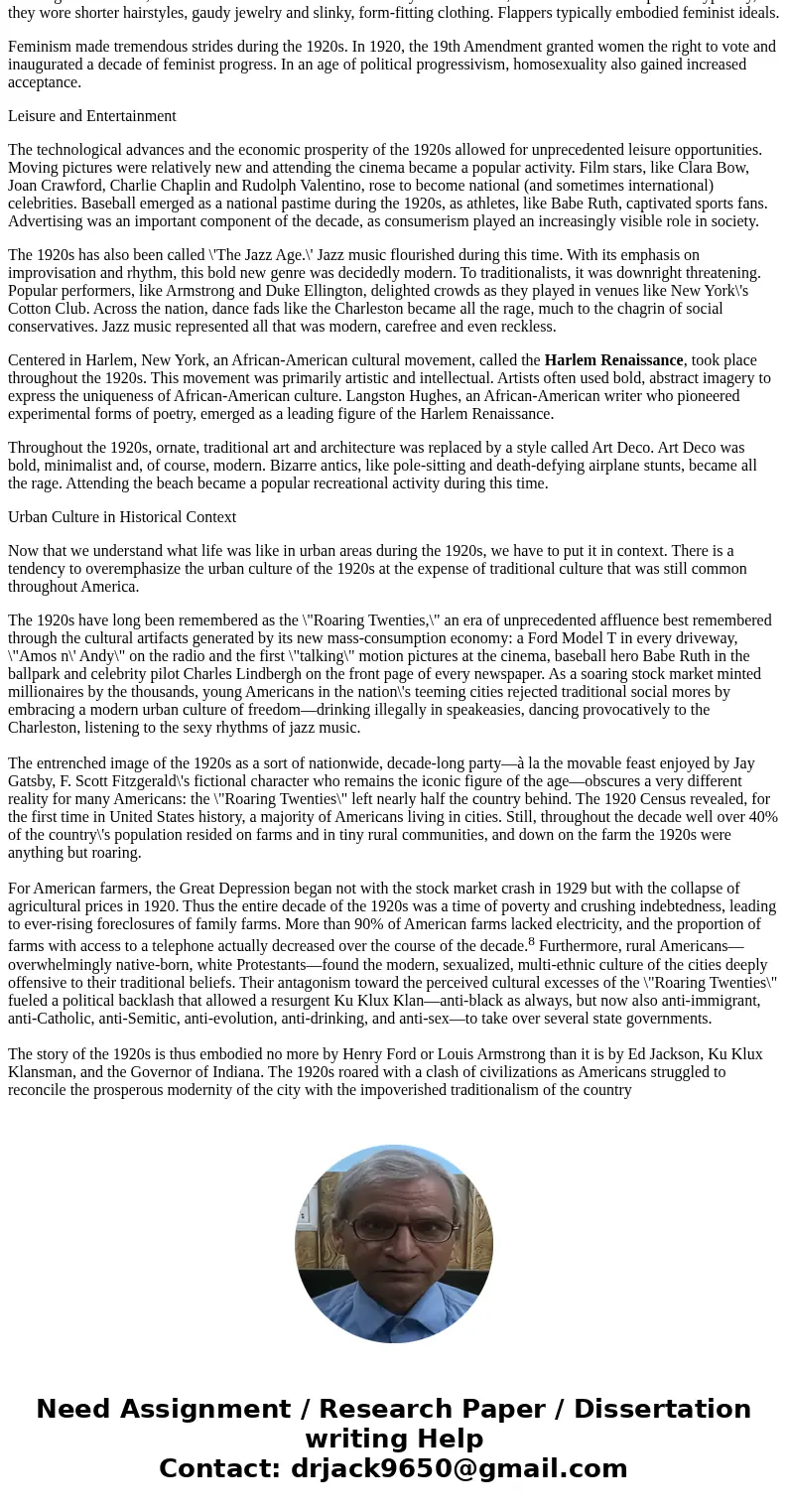The 1920s was a pivotal decade in American history a time wh
The 1920s was a pivotal decade in American history, a time when consumer values, in many ways, triumphed. How would you explain the transition to not only a consumer economy, but also a consumer culture? And how is this transition related to the rise of modernism, the emergence of a therapeutic ethos, and changing standards of morality?
Solution
The 1920s was a time of profound change. So significant was this change that the decade is commonly called the \'Roaring Twenties.\' World War I ended in 1918, and Americans were eager for a return to normalcy. Following the Great War (another name for World War I), the United States emerged as the new world superpower. Within a few years, the U.S. economy was booming.
The 1920s was a dynamic decade, characterized by prosperity, leisure, technological advances, consumerism and major shifts toward modern values. Modern values were particularly pronounced in urban locations. As more people relocated to large cities, like New York and Chicago, a way of life developed that was dramatically different from the rest of rural society. This urban culture became the hallmark of the entire decade.
Perhaps you have read the book or seen the movie The Great Gatsby. The Great Gatsby typifies urban culture during the 1920s. If you have read the book or seen the movie, you probably have a good idea of what 1920s urban culture was like. If you are not familiar with this classic, that\'s okay, because we are going to review several themes that were integral to urban culture during the 1920s.
Urbanization and Innovation
In the years leading up to the 1920s, and throughout the decade, urbanization took place at an extraordinary pace. What is urbanization? Urbanization is simply the process by which people move into urban areas and contribute to their growth. For just a moment, let\'s backtrack to the year 1800. This will help us put things in perspective.
In the year 1800, an estimated 5% of the American population lived in urban areas. By the year 1920, that figure jumped to 50%. It is commonly suggested that more people lived in urban areas than in rural areas throughout the 1920s.
Also during this time, more white-collar jobs became available. Blue-collar jobs, like mining, farming and other forms of physical labor, were by no means rare in the 1920s, but they were increasingly being replaced by white-collar jobs in fields such as law enforcement, public service, private business and the like.
The automobile played a crucial role in modernizing society during the 1920s. When the automobile was first invented, it was available only to the extremely wealthy. Henry Ford\'s affordable Model T helped change that. The Ford Model T and similar imitations opened up a whole new world of possibilities for the middle class.
Because of the automobile, people were traveling farther and more frequently. The popularity of this modern machine also helped birth a host of industries, including gas stations, hotels and automobile repair, just to name a few. The automobile created an entirely new, mobile way of life.
Social Issues
Alcohol consumption was an integral part of 1920s urban culture. Although Prohibition had gone into effect in 1920, alcoholic beverages were readily available at illegal bars called speakeasies and through other means, such as bootlegging. Prohibition was inconsistently enforced. In many cases, law enforcement officers were bribed to turn a blind eye to the production and consumption of alcohol. Prohibition is widely cited as a leading cause of organized crime during the 1920s.
Arguably, one of the most prolific symbols of the entire decade is the flapper. Flappers were young women who challenged traditional, Victorian standards of womanhood. They often smoked, drank and danced in public. Typically, they wore shorter hairstyles, gaudy jewelry and slinky, form-fitting clothing. Flappers typically embodied feminist ideals.
Feminism made tremendous strides during the 1920s. In 1920, the 19th Amendment granted women the right to vote and inaugurated a decade of feminist progress. In an age of political progressivism, homosexuality also gained increased acceptance.
Leisure and Entertainment
The technological advances and the economic prosperity of the 1920s allowed for unprecedented leisure opportunities. Moving pictures were relatively new and attending the cinema became a popular activity. Film stars, like Clara Bow, Joan Crawford, Charlie Chaplin and Rudolph Valentino, rose to become national (and sometimes international) celebrities. Baseball emerged as a national pastime during the 1920s, as athletes, like Babe Ruth, captivated sports fans. Advertising was an important component of the decade, as consumerism played an increasingly visible role in society.
The 1920s has also been called \'The Jazz Age.\' Jazz music flourished during this time. With its emphasis on improvisation and rhythm, this bold new genre was decidedly modern. To traditionalists, it was downright threatening. Popular performers, like Armstrong and Duke Ellington, delighted crowds as they played in venues like New York\'s Cotton Club. Across the nation, dance fads like the Charleston became all the rage, much to the chagrin of social conservatives. Jazz music represented all that was modern, carefree and even reckless.
Centered in Harlem, New York, an African-American cultural movement, called the Harlem Renaissance, took place throughout the 1920s. This movement was primarily artistic and intellectual. Artists often used bold, abstract imagery to express the uniqueness of African-American culture. Langston Hughes, an African-American writer who pioneered experimental forms of poetry, emerged as a leading figure of the Harlem Renaissance.
Throughout the 1920s, ornate, traditional art and architecture was replaced by a style called Art Deco. Art Deco was bold, minimalist and, of course, modern. Bizarre antics, like pole-sitting and death-defying airplane stunts, became all the rage. Attending the beach became a popular recreational activity during this time.
Urban Culture in Historical Context
Now that we understand what life was like in urban areas during the 1920s, we have to put it in context. There is a tendency to overemphasize the urban culture of the 1920s at the expense of traditional culture that was still common throughout America.
The 1920s have long been remembered as the \"Roaring Twenties,\" an era of unprecedented affluence best remembered through the cultural artifacts generated by its new mass-consumption economy: a Ford Model T in every driveway, \"Amos n\' Andy\" on the radio and the first \"talking\" motion pictures at the cinema, baseball hero Babe Ruth in the ballpark and celebrity pilot Charles Lindbergh on the front page of every newspaper. As a soaring stock market minted millionaires by the thousands, young Americans in the nation\'s teeming cities rejected traditional social mores by embracing a modern urban culture of freedom—drinking illegally in speakeasies, dancing provocatively to the Charleston, listening to the sexy rhythms of jazz music.
The entrenched image of the 1920s as a sort of nationwide, decade-long party—à la the movable feast enjoyed by Jay Gatsby, F. Scott Fitzgerald\'s fictional character who remains the iconic figure of the age—obscures a very different reality for many Americans: the \"Roaring Twenties\" left nearly half the country behind. The 1920 Census revealed, for the first time in United States history, a majority of Americans living in cities. Still, throughout the decade well over 40% of the country\'s population resided on farms and in tiny rural communities, and down on the farm the 1920s were anything but roaring.
For American farmers, the Great Depression began not with the stock market crash in 1929 but with the collapse of agricultural prices in 1920. Thus the entire decade of the 1920s was a time of poverty and crushing indebtedness, leading to ever-rising foreclosures of family farms. More than 90% of American farms lacked electricity, and the proportion of farms with access to a telephone actually decreased over the course of the decade.8 Furthermore, rural Americans—overwhelmingly native-born, white Protestants—found the modern, sexualized, multi-ethnic culture of the cities deeply offensive to their traditional beliefs. Their antagonism toward the perceived cultural excesses of the \"Roaring Twenties\" fueled a political backlash that allowed a resurgent Ku Klux Klan—anti-black as always, but now also anti-immigrant, anti-Catholic, anti-Semitic, anti-evolution, anti-drinking, and anti-sex—to take over several state governments.
The story of the 1920s is thus embodied no more by Henry Ford or Louis Armstrong than it is by Ed Jackson, Ku Klux Klansman, and the Governor of Indiana. The 1920s roared with a clash of civilizations as Americans struggled to reconcile the prosperous modernity of the city with the impoverished traditionalism of the country


 Homework Sourse
Homework Sourse